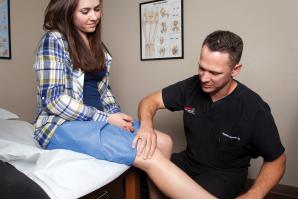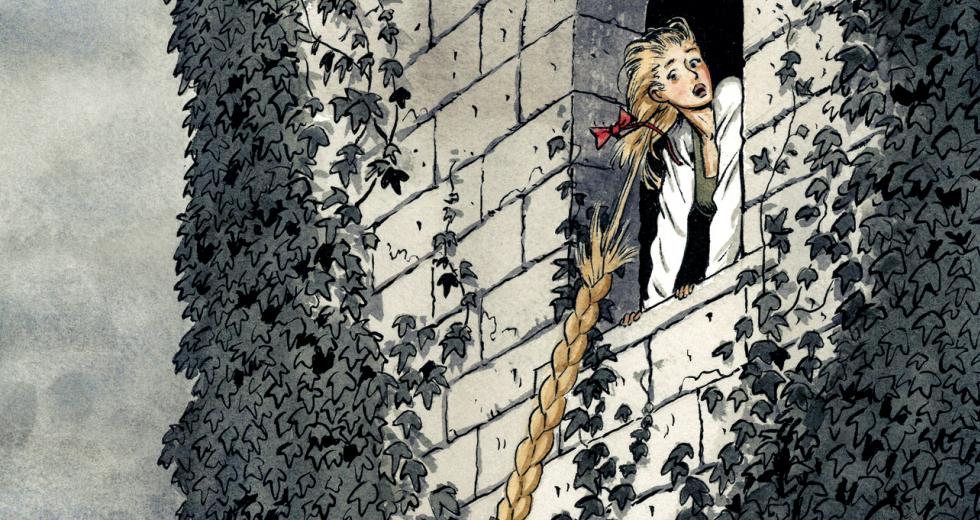Kathy has a secret. Every morning she creeps out of bed before her husband wakes up, slips into the bathroom and meticulously conceals the balding spots on her head. “My husband doesn’t know what I’m up to,” she says, laughing.
Like roughly 30 million other women, Kathy suffers from female androgenetic alopecia, or pattern baldness. Until her early twenties she had thick, wavy, brown locks, but genetics had a different plan: Her mother, grandmother and grandfather all had thinning hair or went bald. She has three sisters, and they all share the same wispy fate.
“You feel insecure,” says Kathy, now 60 and living in Arbor Vitae, Wis. “I’m always looking around at other women and comparing. Even the old ladies! If my sisters and I see an old lady walk by with nice hair, we’ll say, ‘Ooooh, she’s so lucky!’”
Kathy feels anxious each day. “If you go out and you haven’t fixed it just right, you feel like you have a big neon sign on your head saying, ‘LOOK AT MY THIN HAIR!” She dreads dry climates, which make her hair look even thinner. But then again, the wind is even worse, since, “It’s not a sexy wind-blown look, it’s a freak-show look,” she says. She enjoys boating, but won’t do it without a baseball cap. And as a real-estate agent, she knows that appearances are not irrelevant.
This isn’t just about vanity. Hair is often a woman’s most identifiable feature, which is why, absent a name, men refer to individuals as ‘the blonde’ or ‘the brunette.’ The phrase ‘bad hair day’ is shorthand for karma. Society teaches women from infancy to protect their hair at all costs. In the words of one 30-year-old, “I was talking about female baldness in the elevator with my girlfriends, and we all decided we would rather kill ourselves than have our hair fall out.”
There’s also a cruel double standard. A bald Bruce Willis is sexy, a bald Britney Spears is crazy. (In fairness, Britney Spears was actually crazy.) “Baldness is associated with ‘manly’ men, whereas thinning hair on women is associated with old age and lack of ambition,” says Alexis Phan, editor of Sacramento beauty blog etbeaute.com. A study at the Wharton School of Business even suggests that bald male executives have an advantage over their floppy-haired colleagues, as their razor-clean scalps give an aura of dominance, aggression and can-do spunk. But how would the world react if Marissa Mayer, Yahoo’s female CEO, suddenly shaved her head?
“The psychological impact of hair loss for women is profound, and it’s similar to the loss of anyone or anything precious,” says Dr. Sara Gottfried, author of “The Hormone Cure.” “It may make women feel less attractive or that they can’t compete in the marketplace or both. These feelings erode women’s self esteem and confidence, even among the most resilient.”
As one woman puts it, “I didn’t choose hair loss, it chose me. I battled for years. I felt I had lost. I felt withdrawn and depressed and had a feeling of absolutely no hope.” She writes this on WomensHairLossProject.com, where she chronicles her story — anonymously — of coping with androgenetic alopecia. Referring to herself only as “Y,” she emailed me to say, “I’m not sure that the media portrays women’s hair loss much at all. It’s very hush hush. It’s not often talked about.”
It’s a fair point. Who would guess that 40 percent of the patients of pattern baldness are women, or that 30 percent of all women report serious hair loss by age 30? By age 50, this soars to 50 percent. For most of these women, androgenetic alopecia strikes differently than in men: It tends to occur evenly and thinly over the entire scalp, which makes it harder to detect.
The human head has about 100,000 hair follicles, compared to 5 million hairs over the rest of the body (consider the time spent removing that other 5 million). The average hair grows half an inch a month, and we tend to lose 100 strands of hair a day. Visible hair is dead; what matters is the health of the follicle beneath the surface.
A healthy follicle needs a rich supply of iron, protein, vitamins and, above all else, a healthy thyroid. Think of it as the engine beneath the hood of your hair. “When your thyroid hormones are low, the body goes into ‘triage’ mode, similar to an emergency room doctor dealing with a large-scale disaster,” Gottfried explains. “Your body interprets that low thyroid as a disaster and directs your limited resources to the high-priority functions like keeping your body temperature stable and burning calories for fuel; hair is considered lowest priority … You may disagree, and I can relate!”
Specifically, this hormonal imbalance is due to a dip in estrogen, which is why 1 in 3 women have thinning hair during menopause. When estrogen is scarce, the body converts testosterone into the evil, hair-killing hormone DHT, or Dihydrotestosterone. “DHT causes the hair follicle to shrink or even disappear,” says Dr. Sonia Badreshia-Bansal, a Board certified dermatologist who specializes in hair loss. DHT will also cause “wispier, finer hair or hair that seems to stop growing.”
This doesn’t happen overnight. In the case of Kathy, the transformation took years and she never saw any clumps in the sink. The process is often so gradual, so barely visible, that the president of Sacramento’s Natural Look Transitions, Edward Thacker, says most of his clients spend years in denial. “Many of them finally realize it only when they’re looking at photographs. A woman might look at a photo of herself on the beach, and she’ll be shocked to see how thin her hair looks.”
So if you’re obsessing over Facebook photos and noticing an alarming change, what are your treatment options? It’s tough to distinguish the legit from the loopy. The Internet is full of charlatans and miracle cures, such as a video that recommends you scrub your head with jalapeños. The book “Hair Loss (Hair Today Gone Tomorrow)” advises you to “mix together two tablespoons of mayonnaise and olive oil with two whole eggs. Thoroughly blend the ingredients and spread liberally on the scalp and hair.” Thacker says, “I once saw a commercial from a guy in Ohio who said that if his cow licks your head, it will grow back more hair.” In all the years I’ve been in business, I’ve yet to see a home remedy that works.”
Kathy has tried everything. “I’ve read every magazine article on how to make your hair look thicker. Every time I go to the beauty salon, I come back with a $25 product. Women would pay anything to get what they want with their hair.” The blogger Y told me, “I once hung upside down to increase blood flow circulation to my scalp. It didn’t work, but at least I didn’t crack my cranium.”
There are legit treatment options (see sidebar), but for many women, the journey culminates in the nuclear option: the wig. Y, the anonymous blogger, views the wig as a new beginning. “Any woman going through this should know that there is hope. There is always hope,” she writes me. “I choose to wear a wig now. I own several of them, and I affectionately call them ‘my girls.’ My girls allow me to live again.”
As for Kathy? I happened to speak to her at a crossroads. She had just purchased a wig but hadn’t yet committed to wearing it. “I put the wig on, then I looked at myself in the mirror, then I took the wig off, and I looked at myself again … and I got so depressed when I saw the difference, I started to cry.”
Then she came to peace with it. Striking a nostalgic tone, Kathy says, “Growing up, we were always told that guys thought, ‘Long hair is pretty, short hair is cute.’ And I used to have long hair, so maybe that’s part of the problem. I had my time. Maybe it’s time for me to pass the torch.”
Kathy and her sisters are about to go on a Caribbean cruise, and she plans to use this opportunity — the anonymity of strangers — to segue into the wig. “I can accept it. I’ll move on,” she says. “Besides, I’m healthy and I’m thankful for that. Maybe I have bad hair genes, but I have plenty of other good genes.”
Too Many Hairs in the Brush?
Let’s say you get diagnosed with androgenetic alopecia. You probably have some questions.
What should I do first?
See a doctor and have your thyroid checked. “Before my patients
start looking for a solution in a box from the drugstore or a
pill bottle from their dermatologist, I encourage them to look
inside their bodies,” says Dr. Sara Gottfried, author of “The
Hormone Cure.” Blood tests will help find the root cause.
Is Rogaine a legit option?
Yep. It’s the brand name for minoxidil, which you can score over
the counter. According to hair expert Dr. Sonia Badreshia-Bansal,
“It’s the only FDA-approved medication for female pattern hair
loss. It has been proven to dilate blood vessels, which allow for
more oxygen, blood and nutrients to reach the hair follicles,
resulting in new, thicker and better hairs.”
Any downside to Rogaine?
It often takes six months to see any difference, you have to fuss
with it twice a day and if you stop using it, the hair growth
will vanish and you’ll revert to your original condition, if not
worse.
Your overall health goes into this, right? Do I need to
eat differently?
A healthy diet feeds into the equation. “Vitamins A and D are
necessary for proper thyroid function,” Gottfried says. “Aim for
5000 mg of Vitamin A daily.” She recommends eating low-mercury
fish, such as herring, sardines and cod. You could also benefit
from evening primrose oil (this helps curb the conversion of
testosterone to DHT), as well as extra helpings of “lysine” and
protein — meat, poultry, soy, eggs, cheese and sardines.
Sardines, really?
It beats rubbing jalapeños on your head.
What about the options from a hair loss place or
aesthetic surgery center?
The options include:
• Scalp massage. Edward Thacker, president of Sacramento’s
Natural Look Transitions, a hair restoration center, says this is
better than nothing, but admits it’s “only moderately
effective.”
• Lasers. According to the Natural Look Transitions website, it
stimulates hair follicles and “increases the blood supply to the
scalp by 54 percent after one treatment.”
• An integration system. A spider-web-type thingy injects your
hair with extra depth and structure.
• A hair graft. This can stay on for weeks at a time, even with
swimming and showering. You can feel the wind blow through your
hair.
For more information, visit americanhairloss.org.
Recommended For You

Avoiding the Pop
Why do so many women tear their ACL, and how can they prevent it?
In one of the crueler twists of sports, ACL tears often happen in freak accidents that you can’t really control. Seventy percent occur without contact. Even more cruelly, a woman is four times more likely than a man to tear the ligament — especially if she’s young and active.

Juiced
Bowel Formula No. 2, friend or foe?
It’s a seductive pitch: Cleanse your body. Feel healthy. Lose weight.
You only have to do one thing: starve.




Comments
you could also shave your head. Bald women are crazy - crazy hot.